The first-quarter 2019 edition of the Oklahoma Economist showed that net domestic migration to Oklahoma has been negative in each of the past three years (2016-18), resulting in the state’s slowest population growth since 1990. It also noted that residents with bachelor’s degrees or higher have accounted for virtually all the recent net outflow. This edition examines the recent “brain drain” from Oklahoma and compares it with past net outflows of college graduates from the state and recent experiences of nearby states. While the data show some concerning trends for Oklahoma, there also may be some silver linings.
How many, how educated, how old?
College graduates have been moving out of Oklahoma, on net, in every year since 2013 (Chart 1). The average net outflow during that period (through 2017, the last year for which detailed data are available) has been over 5,300 college graduates per year._ While 5,300 people represent less than 0.2 percent of the state’s population, they account for over half a percent of the population with college degrees. They also are more than the annual number of bachelor’s degrees granted at either the University of Oklahoma or Oklahoma State University.
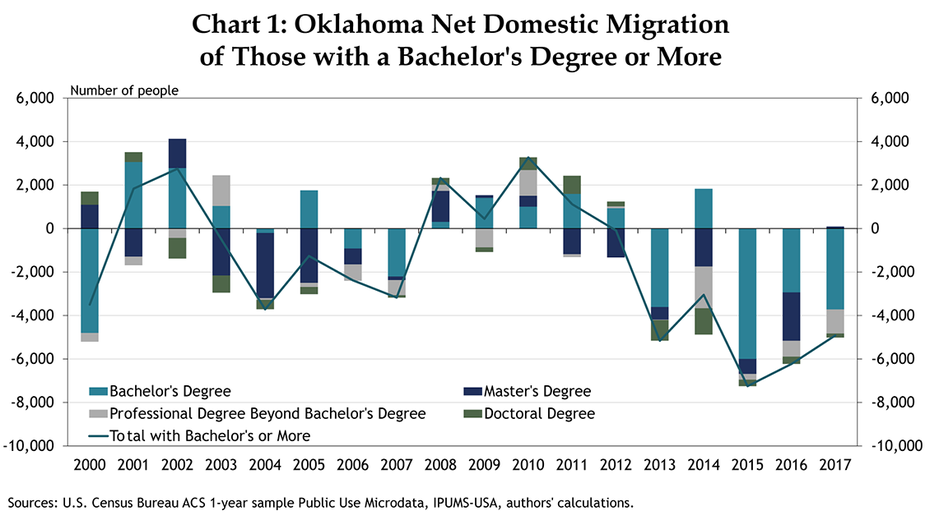
The recent net outflow followed a period from 2008 to 2012 when Oklahoma had positive or flat net domestic migration of college graduates in each year. The largest net inflow occurred in 2010, when over 3,000 more college graduates moved into Oklahoma than moved out.
Prior to 2008, Oklahoma also had a net outmigration of college graduates from 2003 to 2007, as well as in 2000, the earliest year for which annual state data on domestic migration by educational attainment are available. However, four of the past five years—2013, 2015, 2016 and 2017—have been the largest net outflow years for college graduates from Oklahoma since at least 1999.
The net outmigration of college graduates in recent years has been fairly consistent across levels of degree attained. In most recent years, both residents with bachelor’s degrees and those with degrees higher than bachelor’s degrees have had net outmigration. This is somewhat different from the outmigration of 2003 to 2007, when more of the outmigration was of Oklahomans with higher degrees than a bachelor’s degree.
Looking at age cohorts, most of the net outmigration in recent years, at least through 2016, was among college graduates of “prime working age”—those 25-34 and 35-54 (Chart 2). However, that trend changed in 2017, as slightly more of those ages 25-34 with bachelor’s degrees or higher moved into Oklahoma than moved out, for the first time since 2012. At the same time, Oklahomans older than 54 with college degrees moved out in 2017 at their highest rate since 2001, while recent college graduates—those under 25—continued to have increasing net outmigration.
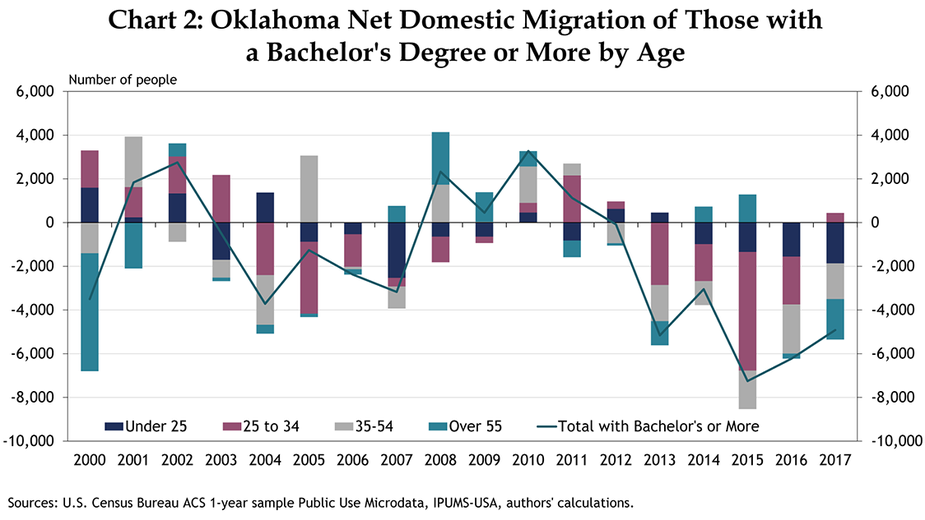
From where, and to where?
In terms of which areas of the state have been losing the most college graduates, annual educational attainment data on migration in Oklahoma are reported consistently only for the Oklahoma City metropolitan statistical area or counties therein._ These data are also only available back to 2005. The trends for the state’s largest metro are similar to those for the state as a whole, with more college graduates recently moving out than moving in (Chart 3).
Several factors help the Oklahoma City area relative to the rest of the state, though. One is that the net flow of college graduates into the metro from other parts of Oklahoma has remained positive in most years, with 2014 the only recent exception. In addition, residents with less than a bachelor’s degree have continued to move into the metro area from other places. Total domestic migration to the greater Oklahoma City area also improved in 2018 after falling nearly to zero in 2017.
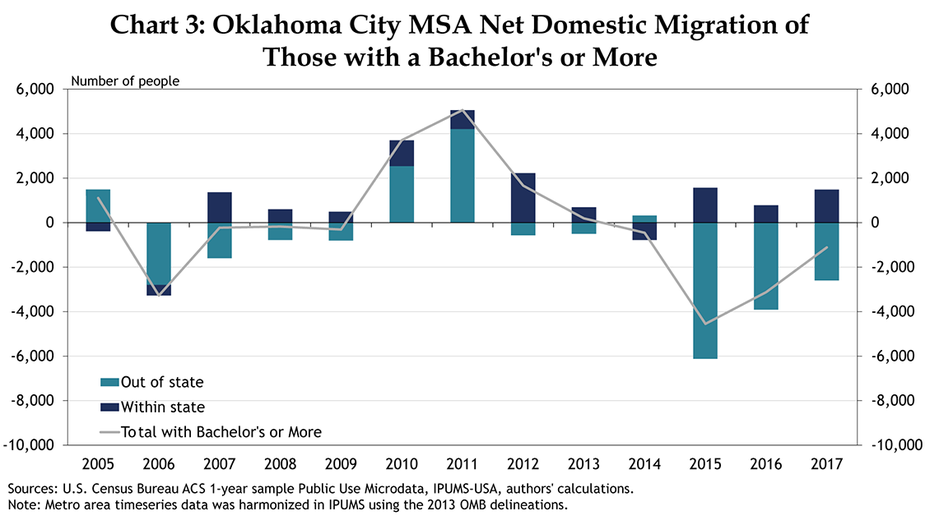
The states attracting the largest number of Oklahoma college graduates in recent years are spread across the country, but the largest destination by far has been Texas (Chart 4). This is similar to the state’s previous “brain drain” from 2003 to 2007, when more Oklahomans with bachelor’s degrees or higher moved to Texas, on net, than to the next three destinations combined. The only other state among the top five destinations in both time periods is Washington. In recent years, many Oklahoma college graduates also have moved to Colorado, Arkansas and California, whereas from 2003 to 2007, the most popular destinations in addition to Texas and Washington were Illinois, Kansas and North Carolina.
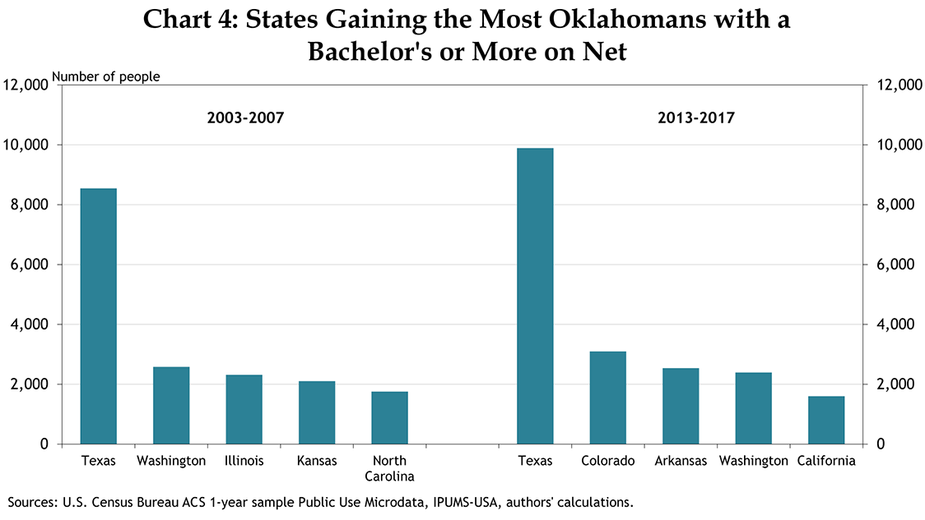
Looking specifically at migration of college graduates to Texas, the vast majority of Oklahoma’s recent outflow has been to the Dallas-Fort Worth metro area, especially in 2015 and 2016 (Chart 5). This was a change from as recently as 2011 and 2012, when the state attracted more college graduates from Dallas-Fort Worth than it lost. Encouragingly, the outflow to the south slowed considerably in 2017, and Oklahoma actually gained college graduates from parts of Texas other than the Dallas-Fort Worth area. _
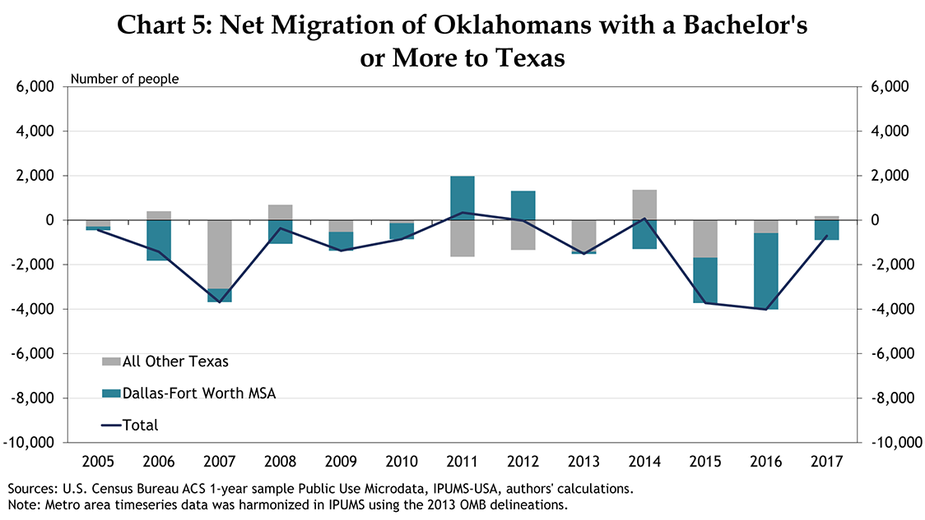
Comparison with nearby states
Examining states that border Oklahoma shows the state is not alone in its recent outflow of people with bachelor’s degrees or higher. While Texas, Colorado and Arkansas have seen net overall inflows of college graduates from elsewhere in the United States in recent years, others have had net outflows. Texas and Colorado each now has had more college graduates move into the state than out every year since 2004, while Arkansas’ net inflow has been smaller and more variable over the past two decades as a share of its population (Chart 6).
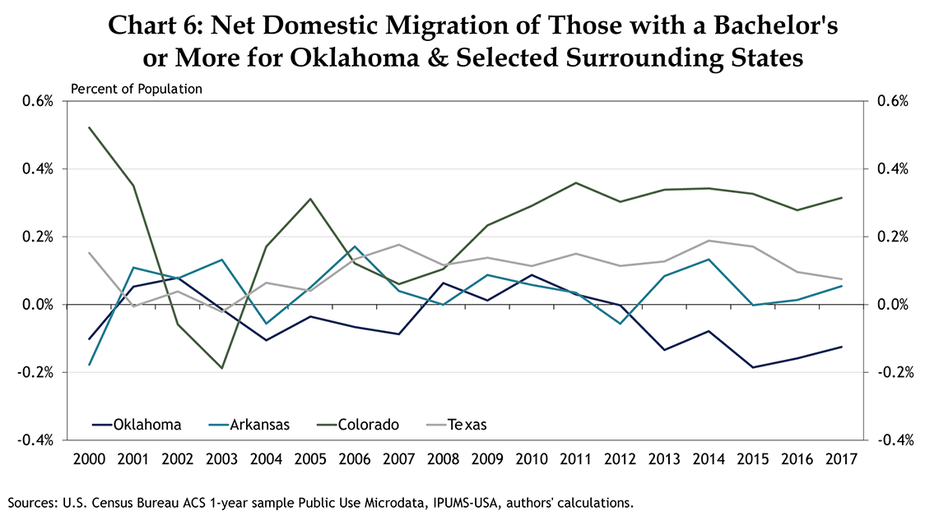
The other three states that border Oklahoma—Kansas, Missouri and New Mexico—experienced trends similar to Oklahoma, with more college graduates moving out than in during each of the past three years for which data are available—2015, 2016 and 2017 (Chart 7). Among those states, Missouri has had the most similar pattern of migration flows of college graduates as Oklahoma throughout the past 15 years, while in New Mexico, the recent net outmigration is in contrast to a steady inflow of college graduates from 2004 to 2012.
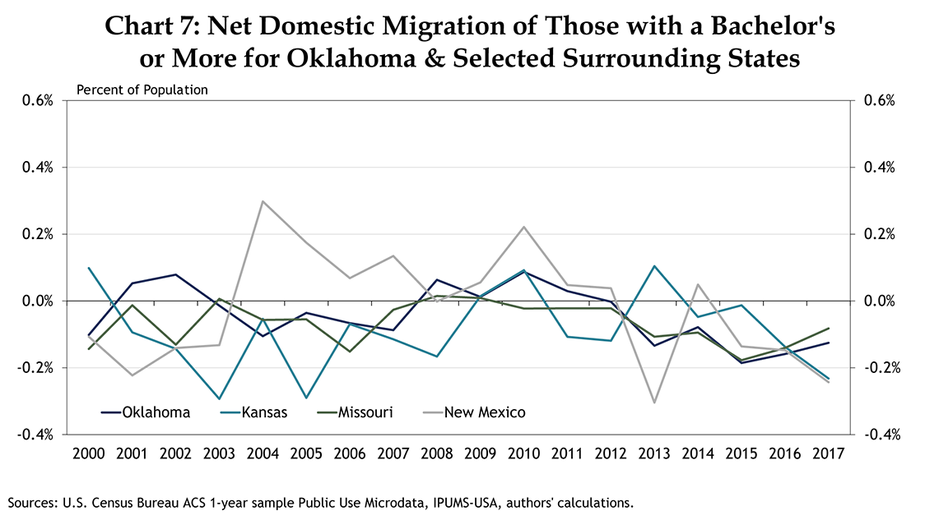
Consequences and silver linings
The recent trend of outmigration of college graduates from Oklahoma presents some challenges. Perhaps most directly, having more college graduates move out than move into the state can affect total educational attainment, which in turn could affect overall incomes and tax revenues, as higher educated people tend to earn and spend more. While educational attainment in terms of college graduates has continued to grow in Oklahoma and the Oklahoma City metro area the past five years, as current residents have gained more education, the pace of growth has been less than in the nation as a whole (Chart 8).
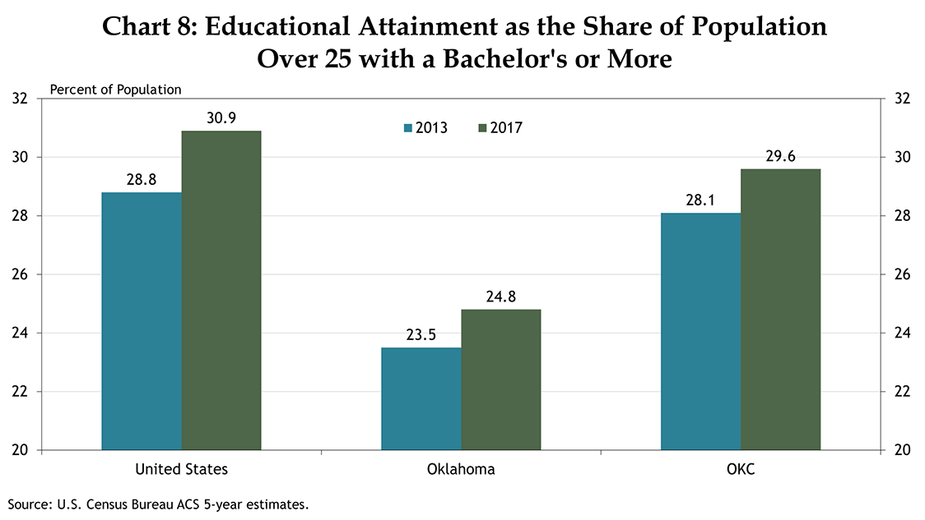
However, the data also may have some silver linings. First, the net outflow of college graduates was less in 2017 than the previous two years, for both the state and the metro, and especially to Texas. In addition, overall net domestic migration, regardless of educational attainment, was not as bad in 2018 as in 2017 (detailed data on migration by educational attainment not yet available). Moreover, Oklahoma outmigration of college graduates as a percent of population has been similar to several adjacent states, suggesting that recent challenges may not be unique to Oklahoma.
Finally, the net outmigration of college graduates in recent years has been due almost completely to more people leaving, meaning the flow of people into the state with bachelor’s degrees or higher has remained relatively steady. Both Oklahoma as a whole and the Oklahoma City metro area had about as many college graduates move in during the past five years as moved in during the previous five years (Chart 9). As such, the issue in recent years has not been in attracting college graduates necessarily, but in keeping college graduates who are already in the state.
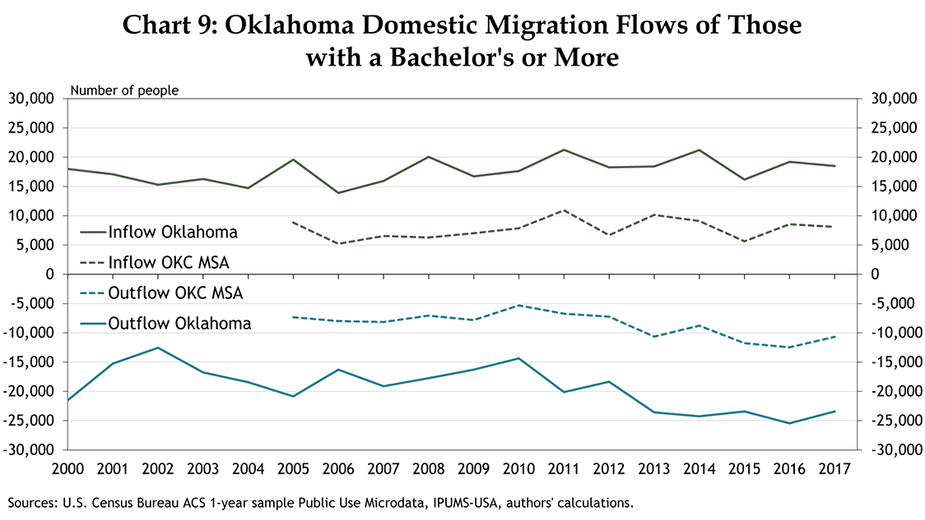
Endnotes
-
1
[1] U.S. Census Bureau ACS 1-year Public Use Microdata Sample (PUMS) for 2018 state migration data by educational attainment are scheduled to be released in November 2019. The historical ACS 1-year sample data analyzed and visualized in this article was harmonized and retrieved from IPUMS USA, University of Minnesota, External Linkwww.ipums.org. For more information on the ACS datasets used in this study, see: External Linkhttps://www.census.gov/programs-surveys/acs/technical-documentation/pums/documentation.html.
-
2
Metro-level ACS 1-year sample data are only reported and included above a certain margin of error, and metro areas are the smallest geographical area consistently defined across the time frame identified in this article. External Linkhttps://usa.ipums.org/usa-action/variables/MET2013#description_section.
-
3
Notably, all of the net outflow to Dallas-Fort Worth in 2017, and sizable amounts from 2013 to 2016, was for recent college graduates—those younger than 25. Some of this flow likely can be explained by rising enrollment of Texans at some Oklahoma colleges (recent enrollment data by state for both the University of Oklahoma and Oklahoma State University, for example, can be found online), and then these students moving to Dallas-Fort Worth after graduation. However, enrollment of Texans at the University of Oklahoma, for example, has been rising steadily since at least 2002, and in some past years Oklahoma’s net migration of college graduates under 25 was positive from the Dallas-Fort Worth area, most recently in 2012 and 2010.
